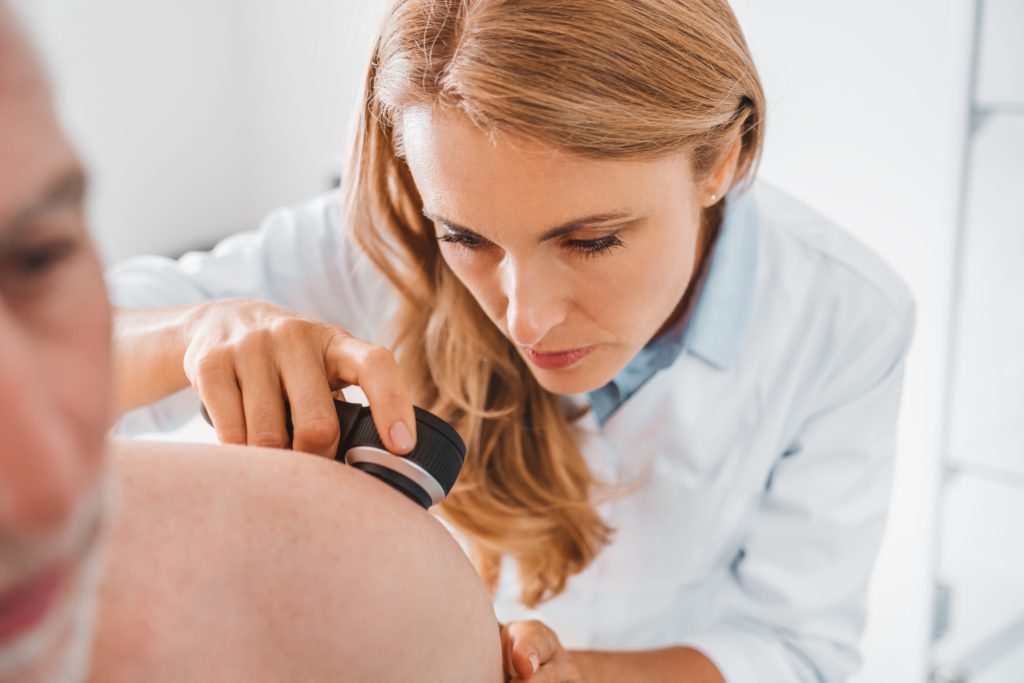Skin cancer is the most common form of cancer in the U.S. There are over 5 million cases diagnosed in the United States each year, and unfortunately the numbers continue to rise.
What can I do to prevent skin cancer?
Being safe in the sun is the best way to prevent all skin cancers. Here are some skin protection tips:
- Apply sunscreen every day, even if you expect to spend most of your day indoors
- Avoid being in the sun from 10am to 4pm
- Avoid tanning beds
- When you expect to be outside for an extended period of time, use a broad-spectrum mineral sunscreen that is water-resistant and has an SPF of 30 or higher. Put the sunscreen on 30 minutes before going outside. Reapply sunscreen every two hours, or more frequently if you have been swimming or sweating a lot.
- If you will be mostly inside, a lower SPF sunscreen will be sufficient for incidental UV light your skin absorbs through windows and ambient light
- Wear protective clothing with built-in sun protection, measured in UPF (Ultraviolet Protection Factor). Also, use broad-brimmed hats and sunglasses.
- Do a skin self-exam once per month and see a dermatologist once per year for a professional skin exam
- Have any skin changes examined as soon as possible by a healthcare provider

Signs and symptoms of skin cancer
The most common warning sign of skin cancer is a change on the skin, typically a new mole, new skin lesion, or a change in an existing mole. When looking for melanoma, think of the ABCDE rule that tells you the signs to watch for:
- Asymmetry: The shape of one half doesn’t match the other
- Border: Edges are ragged or blurred
- Color: Uneven shades of brown, black, tan, red, white, or blue
- Diameter: A significant change in size (greater than 6 mm)
- Evolution: Changes in the way a mole or lesion looks or feels (itchy, bleeding, etc)
What changes in the skin occur due to exposure to the sun?
Exposure to the sun causes most of the fine and coarse wrinkles and age spots on our faces. Over time, the sun’s ultraviolet (UV) light damages the fibers in the skin called elastin. When these fibers break down, the skin begins to sag, stretch, and lose its ability to go back into place after stretching. You may also get freckles and discolored areas of the skin, benign tumors, and telangiectasias, the dilation of small blood vessels under the skin (spider veins).
What is skin cancer?
Skin cancer is the uncontrolled growth of abnormal skin cells. While healthy cells grow and divide in an orderly manner, cancer cells do not. They grow and divide in a rapid, haphazard way. This rapid growth causes tumors that are either benign (noncancerous) or malignant (cancerous). The three main types of skin cancer are:
Basal cell and squamous cell cancers are less serious types and make up 95% of all skin cancers. They are also referred to as non-melanoma skin cancers and are highly curable when treated early. Skin cancer can occur anywhere on the body, but it is most common in areas exposed to sunlight, such as the face, neck, arms, and hands.
Melanoma, made up of abnormal skin pigment cells called melanocytes, is the most serious form of skin cancer. Melanoma causes 75% of all skin cancer deaths. Left untreated, it can spread to other organs and is difficult to control. Unfortunately, the number of new cases of melanoma has been increasing for at least 40 years.

What causes skin cancer?
Ultraviolet (UV) radiation from the sun is the number one cause of skin cancer. But UV light from tanning beds is just as harmful. Other less common causes are repeated X-ray exposure, scars from burns or disease, and occupational exposure to certain chemicals. It is important to note that exposure to sunlight during the winter months puts you at the same risk as exposure during the summertime.
Cumulative sun exposure mainly causes basal cell and squamous cell skin cancer, while episodes of severe blistering sunburns, usually before age 18, can cause melanoma later in life. Protecting your eyes is very important too. Sun exposure may lead to cataracts, cancer of the eyelids, and possibly macular degeneration.
Who is at risk for skin cancer?
Although anyone can get skin cancer, the risk is greatest in people who have fair or freckled skin that burns easily, light eyes, and blond or red hair. Darker-skinned individuals are also susceptible to all types of skin cancer, although their risk is lower. It should be noted, however, that in the last two decades the incidence of melanoma has risen by 20% among Hispanics.
In addition to your complexion, other risk factors include having a family or personal history of skin cancer, having an outdoor job, and living in a sunny climate. A history of severe sunburns and several large and irregularly-shaped moles are risk factors unique to melanoma.
While skin cancer is currently prevalent in the U.S., we can reduce the statistics with knowledge and awareness. Remember the dos and don’ts while in the sun. Especially reapplying sunscreen every 2 hours and wearing protective clothing, hats, and sunglasses year-round. Doing these simple things can help us to stay cancer-free with healthy-looking skin!
Facts about our skin
- Skin is the body’s largest organ
- Skin protects against heat, sunlight, injury, and infection
- Skin helps to control our body temperature and store water, fat, and vitamin D
- Skin has several layers, but the two main layers are the epidermis (upper or outer layer) and the dermis (lower or inner layer)
- The epidermis (outer layer) is made up of 3 kinds of cells: squamous, basal, and melanocytes
How Can We Help?
Legal and Privacy
Quick Contacts
- (630) 884-4449
- Questions@mirror.care
-
Mirror Care Pharmacy 17W535 Butterfield Rd Suite 001
Oakbrook Terrace, IL 60181
Receive Updates from Mirror Care
- Copyright 2025 Self Therapeutics, LLC

